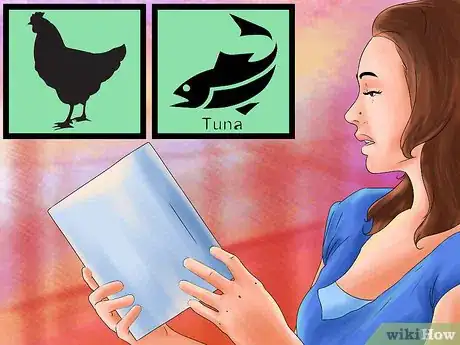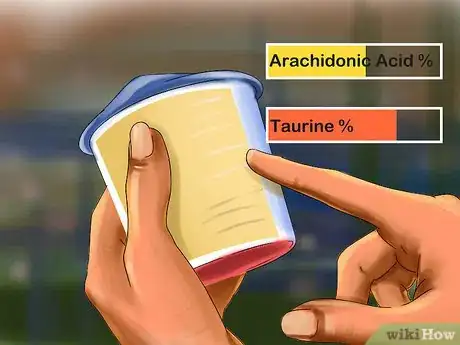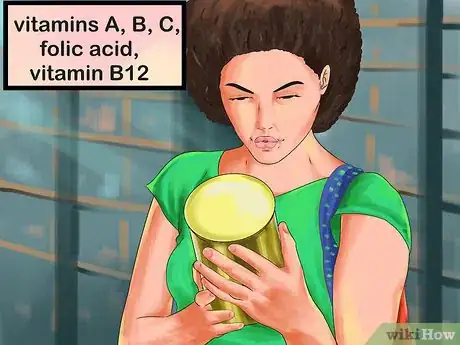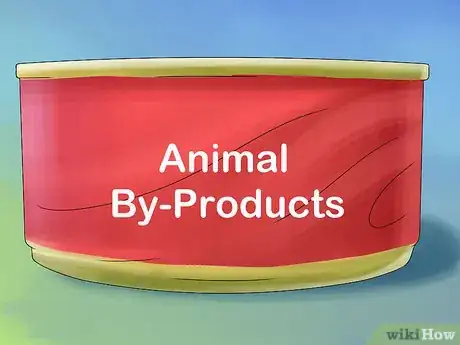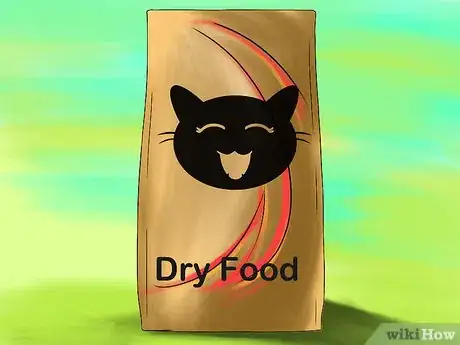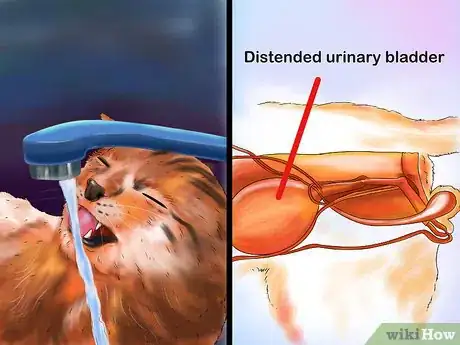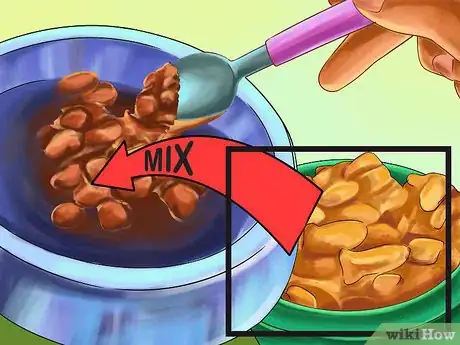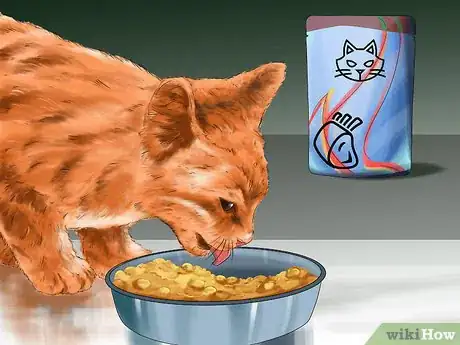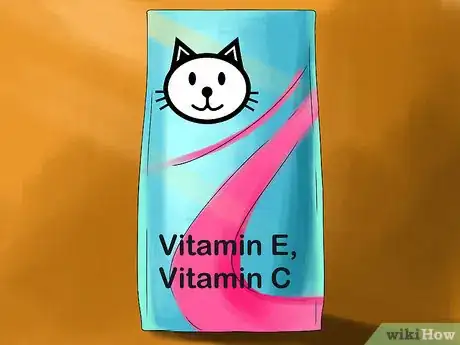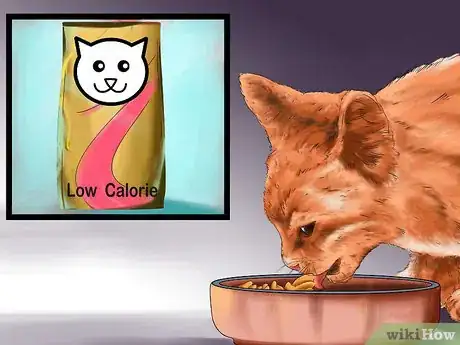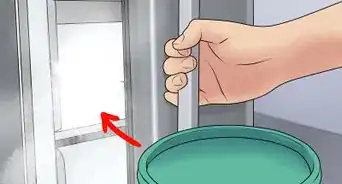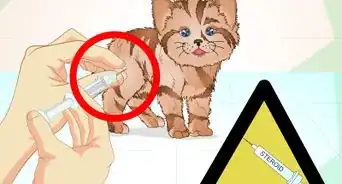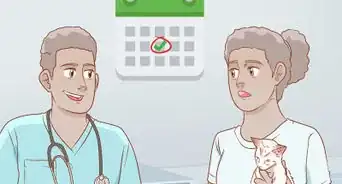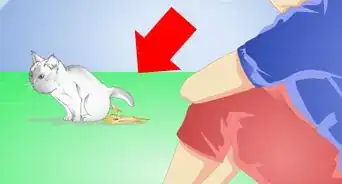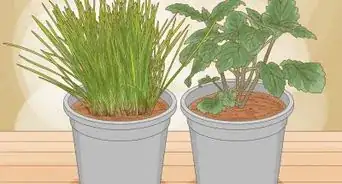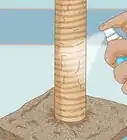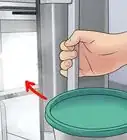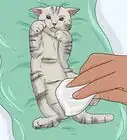This article was co-authored by Lauren Baker, DVM, PhD. Dr. Lauren Baker is a Veterinarian and Assistant Scientist at the University of Wisconsin-Madison. With over 10 years in veterinary medicine, she specializes in the concept of “one health,” which uses insights from veterinary medicine to help human medical research. She holds a Ph.D. in Comparative Biomedical Sciences, a Doctor of Veterinary Medicine, an MS in Comparative Biomedical Sciences, and a Bachelor’s degree in Psychology from the University of Wisconsin-Madison.
This article has been viewed 32,987 times.
Picking cat food can be a challenge, especially if you have never purchased food for cats before. Giving your cat the right food will ensure it stays healthy and happy. Choose cat food based on the ingredients in the food. You can also pick cat food based on the type and the age of your cat so it gets the nutrients and energy it needs to thrive.
Steps
Picking Cat Food Based on Ingredients
-
1Check for meat proteins. Cats are obligate carnivores and they need meat-based protein to thrive. Check the ingredients list on cat food to confirm the first ingredient is a meat like chicken, tuna, beef, or turkey. Good cat food will list a specific meat as the first ingredient, rather than 'meat by-products' or 'poultry'..[1]
- If the label just says “meat” or “meat by-product,” it may not be very high quality. Make sure the type of animal protein is specified on the label.
-
2Look for high-quality grains in the food. Many cat foods will contain grains like corn, barley, or wheat. These grains provide carbohydrates for cats, which will give them energy. Ideally, the top 5 ingredients in the food should be meat first, organs second (such as liver), followed by grains and plant matter. Meat should always come before grains and vegetables.[2]Advertisement
-
3Check the taurine and arachidonic acid content. These ingredients are essential to maintaining your cat’s health. If the cat food contains high quality meat content, it should contain taurine and arachidonic acid.[3]
- If the cat food does not contain taurine or arachidonic acid, it likely does not contain animal sources of protein. Avoid cat foods that have plant sources of protein instead of animal sources of protein.
-
4Confirm there are vitamins and minerals in the food. Look for vitamins like vitamin A, B vitamins, vitamin C, folic acid, and vitamin B12 in the food. These vitamins are essential to keeping your cat healthy.[4]
- Minerals like calcium, phosphorous, iron, magnesium, sodium, and zinc should also be listed as ingredients in the cat food. These minerals help your cat maintain healthy joints, bones, and teeth.
-
5Check for by-products. Most cat foods will contain animal by-products. If the food is high quality, it may contain animal by-products like liver, and lungs. These are fine for cats to consume. Lower-quality foods may have animal by-products (such as fur or feathers) that are hard for cats to digest. Avoid lower-quality cat foods with lots of unspecified by-products.[5]
- By-products should appear before the list of grains, plant matter, vitamins, and minerals. They are highly nutritious and come with great benefits.
- Some cat food brands will list the by-products, such as "animal liver or lungs" while other brands may just say "animal by-products." Try to pick a food that specifies the by-product.
-
6Check if the food has been certified by the AAFCO. The Association of American Feed Control Officials (AAFCO) regulates pet food and helps to ensure pet food is to industry standards. Look at the label on the food to confirm it has been certified by the AAFCO. This means the food has been independently tested and deemed safe for pets.[6]
Choosing Cat Food Based on Type
-
1Pick dry food for convenience. Dry food is often cheaper and easier to maintain than wet food. Dry food allows you to leave the food out for the day without having to worry about it going bad. Most adult cats can thrive on dry cat food that is high quality. Make sure the dry cat food contains mostly animal proteins.
- Your cat may prefer dry cat food over wet food, especially if you introduce dry food to the cat early in its development.
-
2Feed the cat wet food if it tends to get dehydrated. Wet cat food can be more expensive and takes a bit more effort to maintain. It can be a good option if your cat is prone to dehydration and urinary tract issues, and is great for maintaining weight since it provides less calories for the same volume.[7]
- Wet cat food is perishable so it should be given to your cat at feeding time as soon as you open it. You should then dispose of any remaining wet cat food so it does not go bad.
-
3Give the cat a mix of wet and dry food. Rotating your cat’s food can help them stay healthy and encourage them to eat at every meal time. Try giving your cat a mix of wet and dry food, alternating between wet and dry. You can also give the cat wet food 1 or 2 times a week and dry food the rest of the week, especially if you are on a budget.[8]
- You can also try giving your cat different brands of dry and wet food to see which one it likes best.
Selecting Cat Food Based on the Cat’s Age
-
1Give kittens food high in protein and fat. Kittens need a diet specifically balanced to support growth, with high-quality protein. Check the ingredients list on the label to confirm the first ingredient is a protein source like beef, lamb, turkey, tuna, or chicken.[9]
- You can find cat food formulated for kittens at your local pet store or online. These foods will contain folic acid and DHA for healthy development. Even if the food is labeled as "formulated for kittens," read the ingredients list to make sure it contains high protein, fat, and other nutrients.
-
2Get low-calorie food for a sedate adult cat. Lazier adult cats should be given cat food that is low in calories to avoid becoming overweight. Look for food that is high in vitamins like calcium, vitamin E, and vitamin C to boost the cat’s immune system. If you have an active adult cat, there is no need to find a low calorie food.[10]
- Adult cats with a lazy lifestyle are at a high risk of becoming overweight, especially if they are given cat food that is high in calories and fat. Speak to your vet about the right food for your adult cat, especially if you worry it is becoming obese.
-
3Feed a senior cat food low in fat. Cats 10 years or older may do better with a low-fat cat food. The cat food should contain proteins that are high quality and easy to digest. The food should also contain vitamins, minerals, and nutrients to help boost the cat’s immune system, as senior cats are prone to health issues.[11]
- Look for cat food that is formulated for senior cats. Most cat food manufacturers will offer food made especially for senior cats.
- While some cats may benefit from a senior food, the term “senior” is not regulated and what 1 company has in their senior diet may differ from another. In general, senior diets tend to be lower in calories and fat, protein, sodium, and phosphorus.
- Senior diets are mostly aimed at reducing stress on the kidneys, as kidney disease is common in older cats. These dietary restrictions may not be necessary for your cat. You should speak with your veterinarian about whether a senior food is right for your cat.
References
- ↑ http://www.hillspet.com/en/us/cat-care/nutrition-feeding/buying-the-best-cat-food
- ↑ http://www.hillspet.com/en/us/cat-care/nutrition-feeding/buying-the-best-cat-food
- ↑ http://www.hillspet.com/en/us/cat-care/nutrition-feeding/buying-the-best-cat-food
- ↑ http://www.hillspet.com/en/us/cat-care/nutrition-feeding/buying-the-best-cat-food
- ↑ http://www.petmd.com/cat/slideshows/nutrition-center/choosing-best-cat-food
- ↑ http://www.petful.com/food/what-is-the-best-cat-food-how-to-choose/
- ↑ http://www.petful.com/food/what-is-the-best-cat-food-how-to-choose/
- ↑ http://www.petful.com/food/what-is-the-best-cat-food-how-to-choose/
- ↑ http://www.petful.com/food/what-is-the-best-cat-food-how-to-choose/
About This Article
To choose cat food, look for a meat product, like chicken, tuna, or beef, as its first ingredient to make sure your cat gets good quality protein. You should also look for grains like corn, barley, or wheat, which provide your cat with healthy carbohydrates it needs. While you’re checking the label, make sure the food you choose contains vitamins like A, B, C, and B12, which are essential to your cat's health. Dry food is a cheap and convenient option but if your cat gets dehydrated regularly or is overweight, wet food might be a better choice. Alternatively, you can mix wet and dry food together in its bowl for an easy compromise. For more tips from our Veterinary co-author, including how to choose the best food based on your cat's age, read on!
